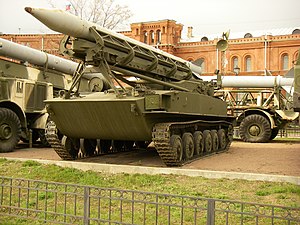| 2K6 Luna | |
|---|---|
 2P16 TEL with 3R9 missile | |
| Type | artillery rocket system |
| Place of origin | Soviet Union |
| Service history | |
| In service | 1960 – 1982 (USSR) |
| Production history | |
| Designer | NII-1 and TsNII-58 |
| Produced | 1960-1964 |
| No. built | 432 SPU 2P16 |
| Variants | 3R10 (nuclear) (FROG-5), 3R9 (HE) (FROG-3) |
| Specifications | |
| Crew | 5 |
|
| |
| Maximum firing range | 45 km (28 mi) (3R9) |
| Warhead | High explosive, nuclear |
|
| |
| Engine | RDTT 3Zh6 |
Guidance system | ballistic |
Launch platform | 2P16 (PT-76-based) |
The 2K6 Luna (Russian: Луна; English: moon) is a Soviet short-range ballistic missile complex. Luna rockets are solid-fuel, unguided and spin-stabilized. "2K6" is its GRAU designation. Its NATO reporting names are FROG-3 (with 3R9 missile) and FROG-5 (with 3R10 missile). From 1965, the 2K6 Luna was replaced by the far more successful 9K52 Luna-M, which was known in the West as the FROG-7.
Design history[]
The Luna system was developed in NII-1 from 1953, under the supervision of N. P. Mazurov. Luna followed the earlier designs 2K1 Mars and 2K4 Filin. While NII-1 was responsible for the rocket, the launch and transporter-loader vehicles were designed by TsNII-58. The initial system name was S-125A "Pion".[1] In 1957 the prototypes of the launch vehicle (SPU S-123A on Ob'yekt 160 chassis), the transloader (TZM S-124A on Ob'yekt 161 chassis) and the 3R5 rocket were ready for evaluations. These were carried out in 1958 in Kapustin Yar and in 1959 in the Transbaikal Military District. As a result of these evaluations, it was decided to abandon the TZM, to improve the SPU and to redesign the rocket. This led to the development of the 3R9 and 3R10 rockets. The decision to start series production was taken on 29 December 1959. The first 5 systems were ready in January 1960 after which the state acceptance trials were carried out until March of that same year. In 1960 the Luna system entered service with the Soviet Army where it remained until 1982.[2] From 1960 till 1964, a total of 432 SPU 2P16s was produced. In the first year alone, 80 launch vehicles and 365 rockets were finished.[3]
System description[]
The missile complex consisted of [4]
- the launch vehicle SPU 2P16 (Ob'yekt 160), based on a modified PT-76B chassis with return rollers and fitted with a launch rail, elevation mechanism, stabilizing jacks and a generator. Combat weight was 18 t;
- the rocket 3R9 with conventional HE warhead 3N15 and with a range of 12 to 44.6 km,
- the rocket 3R10 with a 400 kg nuclear warhead 3N14 and with a range of 10 to 32.1 km;
- a missile transporter 2U663 based on the ZiL-157V with 2 missiles;
- a vehicle 2U662 to transport and store nuclear warheads;
- a mobile crane ADK K52 (on MAZ-502), ADK K61 (on MAZ-200) or 9T31 (on Ural-375);
- sets of maintenance vehicles PRTB-1, 2U659 etc.;
- control and command vehicle PU-2 and
- a training set with training rocket PV-65 or 3R11 with training warhead 3N16.
There have been a couple of variants of the launch vehicle, for example the 2P21 a.k.a. Br-226-II on ZiL-134 8x8 truck, but these never entered service.
The FROG-6 is, according to Western sources[5] the NATO designator for the truck-based training system PV-65. Russian sources[6] however claim that this system is the prototype of the Br-226-I launch vehicle on KrAZ-214.
Operational history[]
Luna entered service in 1960 and remained in service with the Soviet Army until 1982. Each Motorised Rifle and Tank Division had one Rocket Battalion with two batteries, each with two 2P16s.[7] During the Cuban missile crisis 12 2K6 complexes were located in Cuba.
Operators[]
 North Korea - 24 TELs for Luna and Luna-M[8]
North Korea - 24 TELs for Luna and Luna-M[8]
former operators[]
Soviet Union - 200 2P16[9]
 Cuba - 65 2P16[10]
Cuba - 65 2P16[10] East Germany - 13 2P16 from 1962-1977[11]
East Germany - 13 2P16 from 1962-1977[11] Poland[12]
Poland[12] Romania[13]
Romania[13]
References[]
- ↑ Solyankin, A.G.; Zheltov, I.G.; Kudryashov, K.N. (2010). Otechestvenniye Bronirovanniye Mashiny - XX Vek, Tom 3: 1946-1965. OOO "Tsejkhgauz". p. 530-533. ISBN 978-5-9771-0106-6
- ↑ http://military.tomsk.ru/blog/topic-189.html
- ↑ Solyankin, A.G.; Zheltov, I.G.; Kudryashov, K.N. (2010). Otechestvenniye Bronirovanniye Mashiny - XX Vek, Tom 3: 1946-1965. OOO "Tsejkhgauz". p. 530-533. ISBN 978-5-9771-0106-6
- ↑ http://military.tomsk.ru/blog/topic-189.html
- ↑ Steven J. Zaloga - The Scud and other Russian Ballistic Missile Vehicles - Concord Publications Company #7037 - ISBN 962-361-675-9
- ↑ http://military.tomsk.ru/blog/topic-189.html
- ↑ http://military.tomsk.ru/blog/topic-189.html
- ↑ The Military Balance 2010
- ↑ Steven J. Zaloga - The Scud and other Russian Ballistic Missile Vehicles - Concord Publications Company #7037 - ISBN 962-361-675-9
- ↑ The Military Balance 1979-1980
- ↑ Gau L-R., Plate J., Siegert J. (2001) Deutsche Militärfahrzeuge - Bundeswehr und NVA. Motorbuch Verlag. ISBN 3-613-02152-8
- ↑ Steven J. Zaloga - The Scud and other Russian Ballistic Missile Vehicles - Concord Publications Company #7037 - ISBN 962-361-675-9
- ↑ Steven J. Zaloga - The Scud and other Russian Ballistic Missile Vehicles - Concord Publications Company #7037 - ISBN 962-361-675-9
External links[]
- Military analysis network: FROG-3
- 2K6 Luna on Military Russia (in Russian)
- Walkaround of 2P16 with 3R9 rocket in Saratov, on DishModels.ru
| Wikimedia Commons has media related to 2K6 Luna. |
| ||||||||||||||||||||||||||||||||||||||||||||||||||||||||||||
The original article can be found at 2K6 Luna and the edit history here.